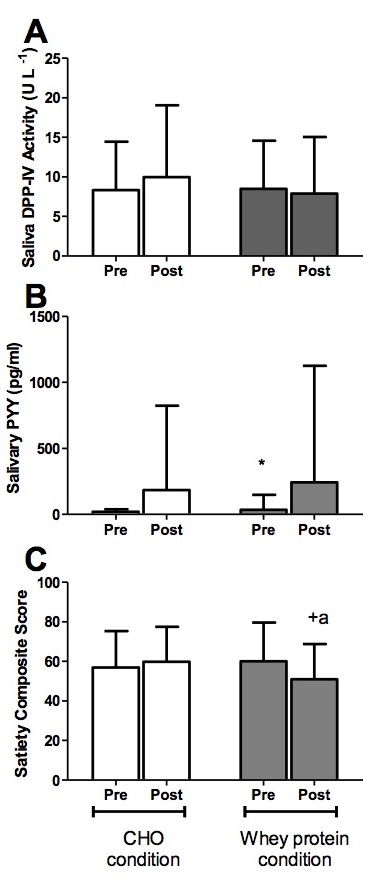By: Caroline E. Hubbard, Heidi A. Kluess, Leslie E. Neidert, Elise K. Mann
Several metabolic polypeptides are present in the saliva. These include peptide YY (PYY), which is a known substrate of the enzyme dipeptidyl-peptidase IV (DPP-IV). DPP-IV cleaves PYY into PYY3-36, a form that can bind to the Y2 receptor in the mouth that is involved in sending signals of satiety to the brain (Acosta et al., 2011; La Sala et al., 2013; Moran, 2009). Although it is suggested that satiety is mediated by a mechanism in the mouth, the physiological mechanism is not well understood. The purpose of this study was to investigate the effects of glucose and whey protein on salivary DPP-IV activity, salivary PYY levels, and feelings of satiety.
Twelve healthy college-age subjects participated in the study. During each visit, subjects either consumed whey protein (Optimum Nutrition, Aurora, IL, USA) or glucose (Sierra Mist, PepsiCo, Purchase, NY, USA). During each visit, satiety was measured via a visual analog questionnaire, and samples of saliva and blood were taken for biochemistry measurements (Chaput, Gilbert, Gregersen, Pedersen, & Sjödin, 2010). All measurements were collected pre-condition and thirty minutes post-condition. A fluorometric assay (Scharpé et al., 1988) was used to measure DPP-IV activity in the saliva and plasma. A PYY enzyme immunoassay (PYY3-36 human, Phoenix Pharmaceuticals, Inc., Burlingame, CA) was utilized to determine salivary PYY protein levels. The visual analog scale contained a series of five questions regarding perceived hunger and satiety, and subjects indicated their answers on a 100 mm line below each question. Satiety composite measures were calculated using a verified mathematical formula from previous literature (Chaput, Gilbert, Gregersen, Pedersen, & Sjödin, 2010).
We analyzed DPP-IV activity, PYY levels, and composite satiety scores. The mean saliva DPP-IV activity levels for the carbohydrate condition and the whey protein condition showed no significant change from pre to post condition (Fig. 1A). There was no significant change between pre and post condition with the plasma DPP-IV for both the carbohydrate and whey protein condition (all: 35.7±8.6U/L). The pre-whey protein condition PYY levels were significantly higher than the pre-carbohydrate condition PYY levels (*p < 0.05 different from Pre-CHO, Fig. 1B). This result can be attributed to natural variation, as the two conditions were counterbalanced. PYY levels did not significantly change from pre to post for either of the two conditions. In the whey protein condition, the satiety composite scores significantly decreased from pre to post (+: p < 0.05 different from pre whey; a: p < 0.05 different from post-CHO, Figure 1C). This decrease in composite satiety score indicated the subjects felt more sated after drinking the whey protein shake. There was no significant change in satiety measure seen for the carbohydrate condition.
These results suggest that macronutrient consumption has a physiological effect on satiety because a significant change was seen in the composite satiety score with the whey protein condition. Although previous literature suggests that there is a mechanism present in the mouth that mediates this physiological response, we did not find any evidence that PYY and DPP-IV are involved. Further research into satiety should be conducted, as understanding the mechanism that mediates this physiological response would allow for better insight into controlling food intake.
Statement of Research Advisor
This project was the second study in a series that the lab performed on mouth-based mechanisms. Caroline was integrally involved in the first study and chose to do this second study as the primary researcher. Caroline won an Undergraduate Research Fellowship from the College of Education and the Office of Undergraduate Research to support this project. Caroline collected the data and ran all of the assays. Caroline presented this work at the Southeast American College of Sports Medicine Annual meeting in February 2016. She was awarded first place in the undergraduate research competition. Caroline is a COSAM Dean’s Medalist and an extremely accomplished student
—Heidi Kluess, Kinesiology
References
Acosta A., Hurtado M., Gorbatyuk O., La Sala M., Duncan D., et al. (2011) Salivary PYY: A Putative Bypass to Satiety. PLoS ONE 6(10): e26137.
Chaput, J., Gilbert, J., Gregersen, N., Pedersen, S., et al. (2010, June). Comparison of 150-mm versus 100-mm visual analogue scales in free living adult subjects. Appetite, 54(3), 583-586.
MS, L., Hurtado, M., Brown, A., Bohórquez, D., Liddle, R., et al. (2013, December). Modulation of taste responsiveness by the satiation hormone peptide YY. FASEB, 27(12), 5022-5033.
Moran, T. (2009, April). Gut peptides in the control of food intake. International Journal of Obesity, 33(Suppl), 7-10.
Scharpé, S., De Meester, I., & Vanhoof, G. (2016, April). Assay of dipeptidyl peptidase IV in serum by fluorometry of 4-methoxy-2-naphthylamine. Heliyon, 2(4).

Figure 1.
Last Modified: